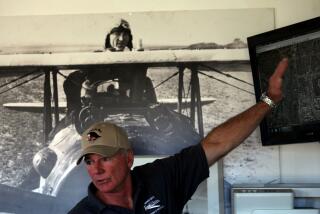Plane Fun
- Share via
CAMARILLO — Vintage planes tested in World War II dogfights buzzed and swooped through sunny skies with the best of today’s sleek experimental aircraft Sunday as thousands watched the aerial antics on the final day of the Camarillo Air Show.
Organizers were happy their first-time aerobatic event at Camarillo Airport drew crowds totaling about 15,000 over the two days, though it was a much smaller attendance than at April’s Point Mugu air show, which reached nearly 200,000.
“We call this a community air show; it’s like an air fair,” said event chairman John Parrish. “This is our first full-blown, complete air show, and I’ve heard nothing but positive remarks.”
The local chapter of the Experimental Aircraft Assn., which helped sponsor the air show, has held less extravagant events in past years that have included aircraft fly-bys, but never aerobatics.
“This started as an airport pancake breakfast for our members to sit around and tell stories, but somehow it got out of hand,” Parrish said. “Now you’re seeing a world-class show, and we’ve got extremely good pilots. These are not people who go around and just accidentally turn an airplane upside down.”
Certainly not Brig. Gen. Steve Ritchie, whom many consider the Air Force’s last ace pilot. Ritchie flew a T-38 jet from Point Mugu Naval Base to the Camarillo show and was greeted with crowds asking for pictures and autographs.
Ritchie--who will retire from the Air Force this year after 38 years in the military--is the only American pilot to ever shoot down five enemy MiG-21 jets, and the last Air Force pilot to obtain the distinction of “ace” since the Korean War. Ritchie, along with a Navy pilot, earned his ace status in the Vietnam War.
A new era of high-tech warfare makes it difficult, if not impossible, for a pilot to become an ace by single-handedly shooting down five enemy planes within a military career, Ritchie said.
“In World War II, there were 1,400 pilot aces. In Korea, 39, and in Vietnam, just two,” said Ritchie, 56. “And the changing nature of warfare is even more pronounced since Vietnam. This is the end of an era, but it’s a good thing if it means we’re not going to have conflicts long enough for pilots to become aces anymore.”
Highly experienced pilots like Ritchie were the attraction this weekend. Consider Jim Modes, who flew in World War II.
Modes spent the eve of his 80th birthday on Sunday flying an AT-6--the same plane he used to train young military pilots 50 years ago--in aerobatic loops and rolls before an astonished crowd that gasped when they heard his age announced.
“They were probably hoping I had a transfusion to get my heart pumping before I went up,” said Modes, who is scheduled to fly in a dozen air shows across the United States this year. “I really don’t feel my age, and even if I get tired or sometimes don’t feel like flying, once you get in the cockpit the adrenaline kicks in.”
Modes travels to air shows with his son, Bill, who helps his dad operate an aerobatics school in Arizona. Bill is not worried that his dad still flies at his age.
“I think he’s safer flying the plane than driving a car,” the younger Modes joked.
“I think so, too,” his dad agreed. “I can’t hit anyone up there and I’m not a hazard to anyone but myself.”
Mike O’Hearn on Sunday flew one of the last models of fighter planes from World War II--the Bearcat. O’Hearn is a pilot for the Confederate Air Force, a nationwide flying museum that owns 135 operating World War II-era aircraft. The Bearcat that O’Hearn flew is one of eight left that still fly, he said.
The seasoned pilot maneuvered his Bearcat through loops, barrel rolls and even a Cuban 8: “Looks like an 8 laying on its side in the sky,” said O’Hearn.
O’Hearn, of Upland, who has been doing aerobatics for 30 years, said there is a mutual attraction in the art of stunt flying between the pilot and the crowd below.
“Their planes are so graceful and agile,” he said, adding that he would never be satisfied just watching. “There’s a thrill to doing it. Why do guys like motorcycles or race cars? And where else can I go 400 miles per hour but in the sky?”
More to Read
Sign up for The Wild
We’ll help you find the best places to hike, bike and run, as well as the perfect silent spots for meditation and yoga.
You may occasionally receive promotional content from the Los Angeles Times.






